(Ocean Robbins) In an episode of the TV show Silicon Valley, Gilfoyle, an overwhelmed software coder, rushes to debug some mission-critical software against a looming deadline. Running out of time, Gilfoyle hits upon a brilliant solution — write an artificial intelligence (AI) script to find and remove the bugs as efficiently as possible.
Related 10 Italian Recipes to Preserve Your Vegetables Using Vinegar
Source – The Food Revolution Network
by Ocean Robbins, May 27th, 2022
It works, and the script gets rid of all the software bugs in mere seconds. There’s just one “minor” issue — in its quest for efficiency, it deletes the bugs by deleting all the software. No more code, so no more bugs.
Oops.
Gardeners also struggle against bugs. If you try to grow your own food, you’ll find plenty of competition for those yummy calories among the denizens of the insect kingdom. You’ll also find plenty of weapons to help you prevail — the home and garden pesticides market generates almost $8 billion in sales worldwide. Unfortunately, many of the products that make up that market cause almost as much collateral damage as Gilfoyle’s bug-destroying AI. In addition to harming the environment and compromising human health, some of them actually exacerbate insect problems in the long run by destroying your garden’s natural defenses against insect predation.
Are there ways to protect your hard-earned crops without hurting your garden, your health, and the balance of nature? In this article, we’ll look at a natural insect repellent for plants and nontoxic formulas you can create from things you may already have, like vinegar, soap, and garlic. These natural insecticides can help you reap a harvest that supports not only your health but the well-being of the entire ecosystem as well.
The Challenge of Gardening: Hungry Pests
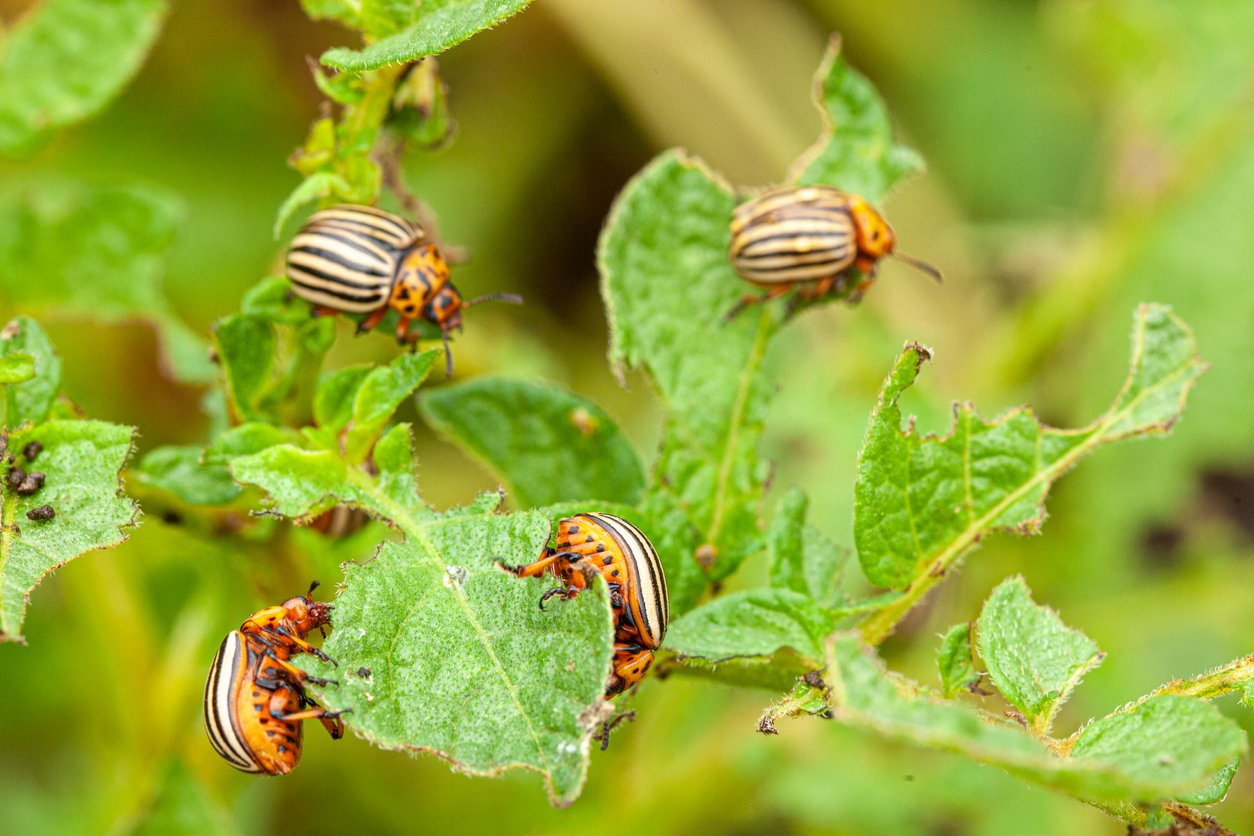
Gardening is one of the most popular hobbies out there. It gained new adherents during the early stages of the COVID-19 pandemic as people sought a way to reduce their dependence on the industrial food supply chain, and its appeal as a pastime and supplemental income source (especially if you count healthy calories as a source of income) appears to be lasting.
It’s no wonder. Gardening provides many benefits, in addition to the obvious one of fresh, delicious, healthy food at your fingertips. It’s good for your mood, your microbiome, your stress levels, and your cardiovascular system. It puts you in touch with nature and the unique qualities of your bioregion and microclimate (what you could call “terroir,” as long as you say it with a very heavy French accent).
There is one significant downside to growing food in a home garden, however — you have to deal with pests (well, you do if you hope to reap what you sow).
And while lots of critters — from deer who will happily jump an eight-foot fence to nibble at your sweet potato greens to neighboring cats who view your raised herb bed as the ultimate litter box — can be considered pests, the most difficult to deal with are typically the tiny critters. Specifically, I’m talking about insects.
Insects, as everyone knows who’s read their Wikipedia entry, are “pancrustacean hexapod invertebrates of the class Insecta.” In other words, boneless six-legged critters with outer shells.
There are a lot of insects out there. While all the humans on the planet weigh, collectively, about 287 million metric tons, it turns out that spiders eat two to three times that amount of insects every single year. So putting all of us on one side of a balance scale and all the insects on the other would be about as lopsided as a grasshopper doing the same thing with you.
And many insects eat plants. In fact, many of their favorite plants are our favorite plants as well. So when you grow crops outdoors, you’re essentially ceding the home-field advantage to the myriad species of insects that have unfettered access to all the yummies you’ve planted.
To regain the upper hand and protect their crops, many home gardeners apply insecticides and other pesticides to their garden beds to control those pests. But many of the most popular formulas, including the pyrethroid insecticides (such as the ominously named Anvil, Scourge, and Fumakilla), may harm the environment and compromise your health.
Fortunately, you don’t have to choose between toxic compounds and a garden destroyed by pests. You can deploy some highly effective and very safe homemade insecticides in your vegetable garden.
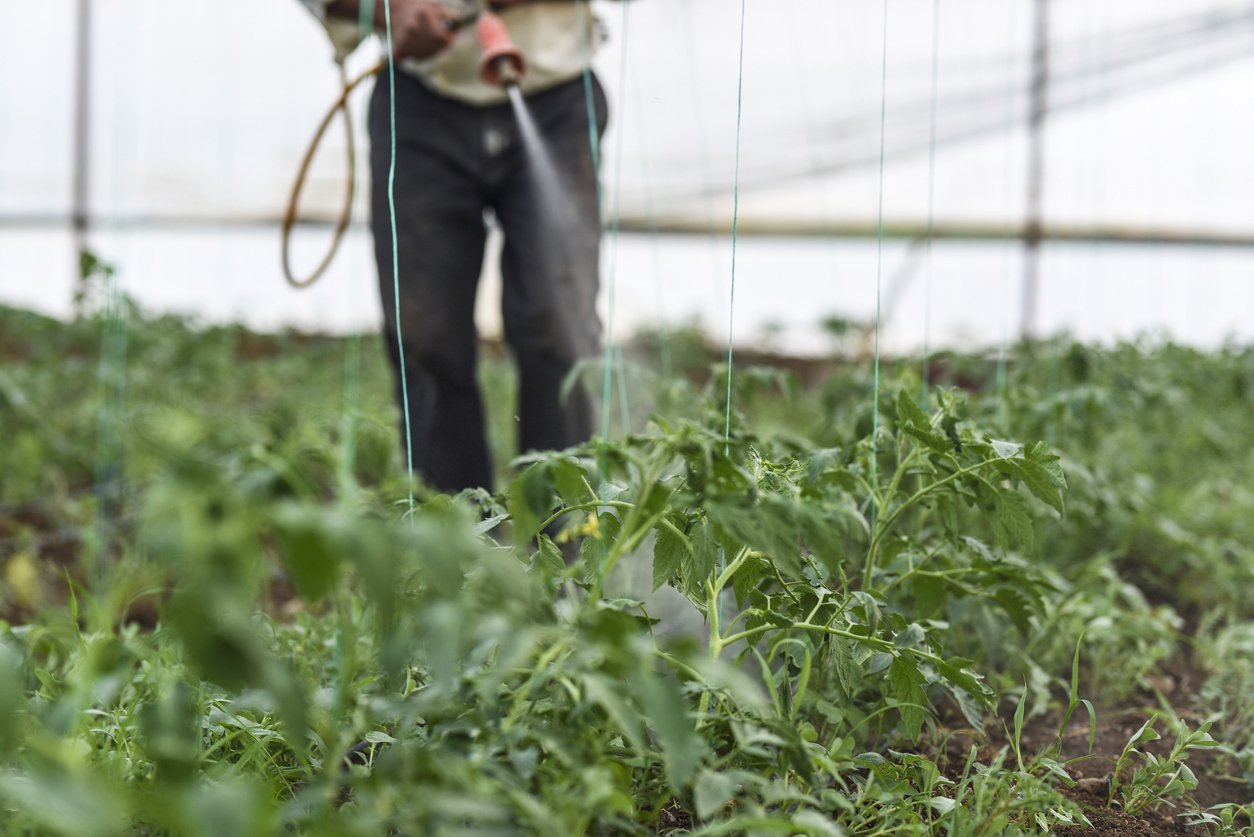
Before we get into the specific formulas, we need to get clear on the difference between pesticides and insecticides. “Pesticide” is a broad term that includes insecticides as well as herbicides and fungicides. They are formulated to deter pests of all sorts, including insects and other bugs, weeds and other plants, fungus and mold, and even larger animals that like to snack on plants.
Insecticides, by contrast, are meant to deter or eliminate just insects, those small invertebrates with six legs that may or may not have wings. In other words, all insecticides are pesticides, but not all pesticides are insecticides.
Why are Insecticides Used?
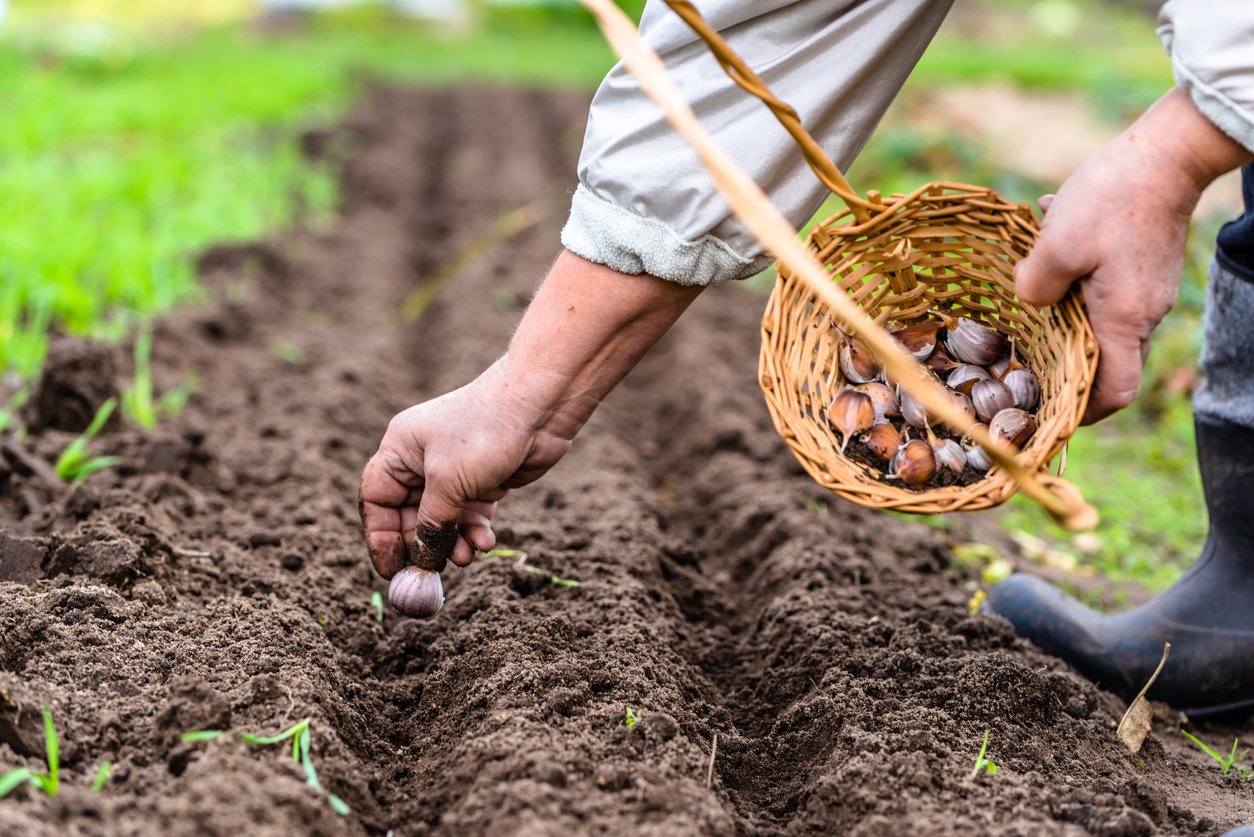
The simplest answer is to remove insects from a plant. It might just be a few bugs, or it could be a large-scale infestation. If the little critters were just using your plants as a walkway, it wouldn’t be an issue. But insects often have mischief on their minds (at least from the gardener’s perspective).
Insects may eat entire leaves, or chew holes in them, which can keep the plant from photosynthesizing. They may suck the nutrients from the plant, keeping it from bearing fruit. They might eat the edible parts of the plant, such as the tomato and cucumber fruit, or broccoli florets. And they might act so destructively that they kill the entire plant.
The best way to get insects off your plants is not to let them get on your plants in the first place. As the saying goes, an ounce of prevention is worth a pound of cure. Ideally, gardeners use insecticides not as their entire insect-fighting strategy, but as part of a systematic approach, such as that prescribed by integrated pest management (IPM).
IPM attempts to keep insect damage to a minimum while at the same time minimizing the hazards to people, property, and the environment. Rather than just pouring poison on the offending pest population, an IPM-minded gardener might recruit beneficial insects and other organisms to help keep the pest species in check. For example, ladybug larvae love to feast on plant-destroying aphids, and praying mantids will happily gobble up moths and beetles.
Other IPM techniques mimic the ways nature keeps pest populations from exploding — rotating crops between different areas of the garden, selecting pest-resistant plant varieties, interspersing onions, garlic, or other plants that tend to deter insects, and planting pest-resistant rootstock.
Ultimately, pest infestations in your garden are a lot like infections in your body — they take hold when the native immune system is compromised. And if the best way to keep your body infection-free is to live a healthy lifestyle — including fresh air, sunlight, healthy food, clean water, and emotional support — the best way to keep insects from eating all your crops is to create a healthy environment for those crops.
This includes nurturing healthy soil, allowing sufficient space between the plants, removing large weeds so your plants can “breathe,” and harvesting fully so you don’t leave rotting leaves or fruits that can attract pests.
Even with all those strategies in place, you may still face unacceptable levels of insect damage. In those cases, a homemade natural insecticide can be a useful tool in your toolbox.
Why Choose a Natural Insecticide?
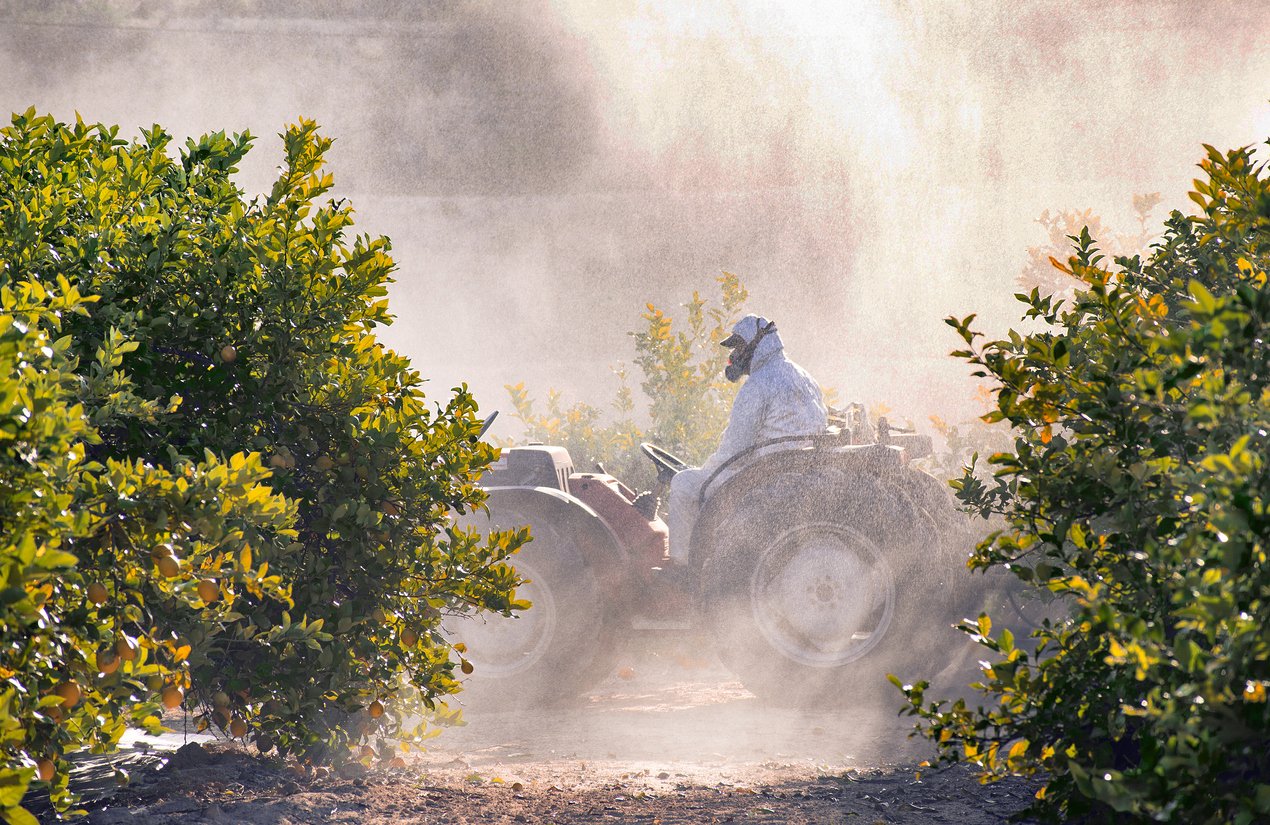
Conventional agriculture around the world relies heavily on synthetic insecticides. And through years of observation and research, we’ve developed a clear understanding of the negative long-term effects of many of these compounds on people, animals, and the environment.
Synthetic insecticides can contribute to water and air pollution. And these chemicals may remain on edible portions of plants when harvested and consumed, despite your best efforts to wash them off.
Spraying insecticides puts farmers and farmworkers at risk, as they can cause harm via skin or eye contact, or when inhaled. And there’s plenty of evidence that these chemicals can waft into nearby homes, where their concentrations and harms can be amplified.
Broad-spectrum insecticides don’t just target the pests you’re trying to get rid of. They can also harm beneficial insects such as pollinators (bees and butterflies), without whose help you may not have anything to harvest at all.
And just as broad-spectrum antibiotics kill your gut bacteria indiscriminately and wipe out as many beneficial as harmful microbes, chemical insecticides can kill beneficial critters in your garden and decimate its natural defenses. This perpetuates a vicious cycle in which you must continue to apply more and more insecticides because the garden ecosystem has lost its ability to defend itself.
In contrast to commercial insect-killers, the best natural insecticides use safe, generally nontoxic ingredients that will not harm humans or most other animals (we’ve got some cautions for you below). Neither do they hurt creatures that prey on the insects, or the soil or water in the garden. This is why they are allowed in organic farming and gardening.
So let’s look at some different bug sprays and insecticides you can DIY. You’ll not only save time and money, but you’ll also protect your health and the environment (and your garden!).
DIY Bug Spray Safety
Before we begin, a few cautionary notes. While homemade insecticides are typically far safer than industrial ones, you still want to treat them with respect and follow sound safety protocols. Label them, so you don’t confuse them with other household liquids. (“Is that cayenne pepper spray or contact lens solution? Oh, well, only one way to find out.”)
And keep your natural insecticides away from children, as they can irritate skin and mucous membranes.
Some of the sprays can be harmful to companion animals. Dogs and cats are susceptible to allium toxicosis (what veterinarians call “garlic poisoning”) and can experience digestive upset if they consume chili peppers.
Tomato leaves are toxic to dogs, cats, and horses, and can lead to drowsiness, stomach pain, and breathing difficulties.
Natural Pest Control for Gardens:
5 DIY Bug Sprays for Plants
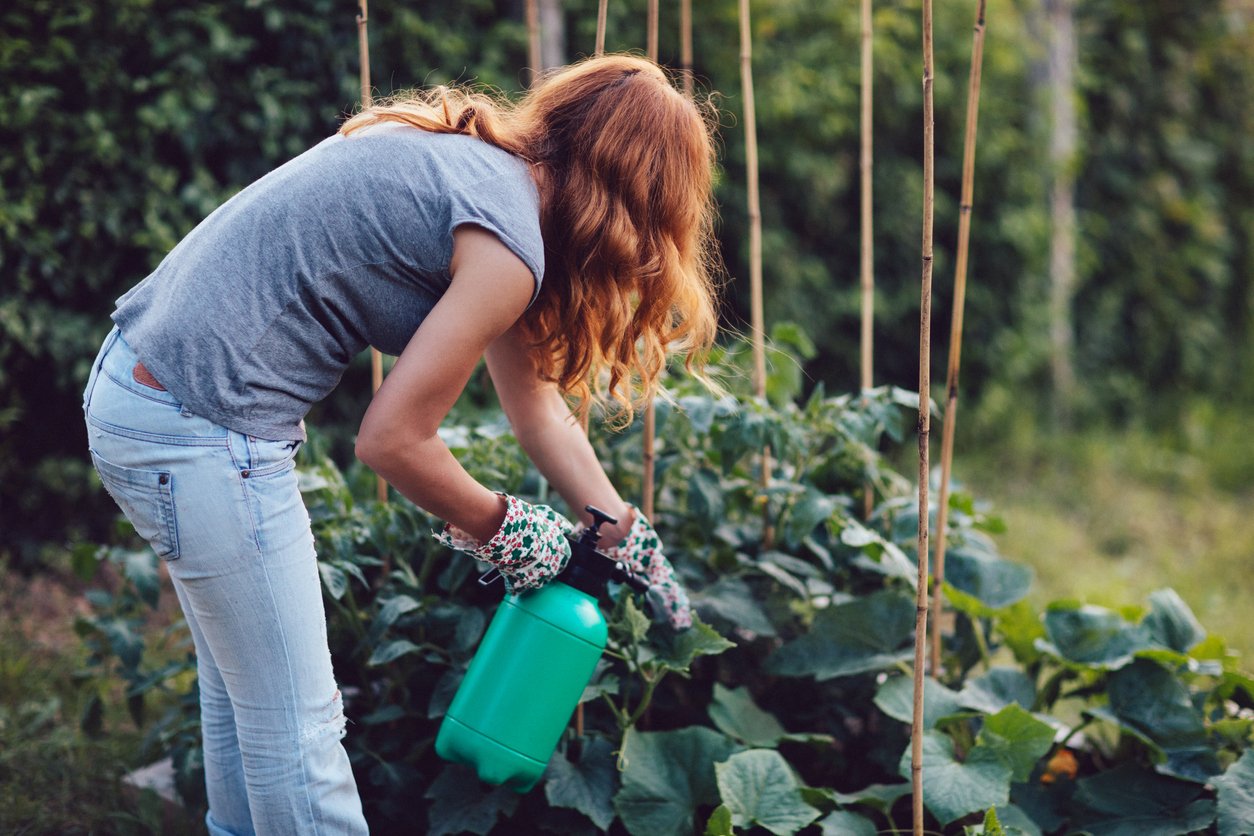
Insecticidal Soap Spray
It couldn’t be easier to make this insecticide, which works on small, soft-bodied insects like mites, aphids, thrips, mealybugs, whiteflies, and immature leafhoppers. (Immature ones don’t have wings, and also probably shout, “Hey, Mom, look how high I can jump!” a lot.)
This insecticidal soap recipe works by dissolving their exoskeletons, which dehydrates and desiccates them.
Also known as horticultural soap, this homemade aphid spray is non-toxic to animals and birds and doesn’t harm beneficial insects. While you can buy it commercially, it’s cheaper and just as effective to make your own.
The formula couldn’t be simpler:
- 4-5 tablespoons of liquid dish soap (NOT detergent)
- 1 gallon of water
- Mixed and add to a spray bottle (or, if your spray bottle has a one-quart capacity, add a tablespoon per quart of water and mix right up in there).
Make sure the dish soap doesn’t have petroleum-based ingredients, added fragrances, or essential oils. ECOS and Dr. Bronner’s are well-known brands that offer unscented varieties.
To use the DIY soap spray, cover any infested plants evenly, from top to bottom. Make sure the insects get good and wet.
Cayenne Pepper Spray
Nothing says you mean business like hosing down some garden pests with hot pepper spray. It repels insects like aphids, beetles, leafhoppers, and spittlebugs (which live up to their disgusting name with the revolting habit of leaving frothy mounds of spittle on the plants they’ve been enjoying — as you can tell, I’m not a fan). Of course, hot pepper also repels most mammals, including deer, squirrels, and domestic pets.
It’s the capsaicin in the peppers that does the trick; a natural irritant, it produces a burning sensation upon contact that acts as an effective deterrent to munching, nibbling, and, yes, producing gobs of spittle.
To make the spray, mix two tablespoons of powdered cayenne pepper into a gallon of water. Add a couple of drops of unscented soap to help the liquid stick to leaves, stems, and fruits. Whisk it thoroughly, let it sit overnight to grow ornery, and then use a funnel to get it into your spray bottle.
Alternatively, you can also use commercially manufactured hot sauce that contains capsaicin. The higher the Scoville number, the more firepower the sauce contains. Fun fact — cayenne peppers clock in at about 50,000 Scovilles, while the Carolina Reaper, according to the Guinness World Records the hottest chili pepper in the world, rings the bell at 2,200,000 Scovilles. Just thinking about this pepper can make your eyes water.
Be very careful when you handle this stuff. Keep it away from your eyes, and wash your hands thoroughly after touching cayenne or other whole, liquified, or powdered hot peppers. Do not rub your eye or scratch your nose unless you want to start an impromptu therapy session that involves lots of crying and a bunch of primal screams thrown in for good measure. And, not to be too graphic about it, making this spray is not something I recommend doing in the nude.
If you grow your own cayenne peppers, you can make a fresh cayenne spray by blending (keep that lid on good and tight!) a half cup of fresh peppers in two cups of water, then adding a couple of drops of soap. Unless you have a really good blender, however, you may find it difficult to use this mixture in a spray bottle without the bottle nozzle clogging.
You can also benefit from the deterrent effects of hot peppers by interplanting them directly in your garden beds, in between crops that might otherwise get bothered by those aphids, beetles, and spittlebugs.
Garlic Spray
Shocking, I know — not every creature loves the smell and taste of garlic! Rather than try to educate the palates of mealworms, aphids, mites, caterpillars, armyworms, cutworms, beetles, slugs, mosquitoes, and flies, you can take advantage of that fact by making your own garlic spray.
It turns out that the same compounds in garlic — sulfur and allicin — which are so beneficial to human health, offend the noses of flying and crawling insects. The Very Hungry Caterpillars and other critters that are far cuter in children’s books than in your cabbage patch will seek other plants to eat and on which to lay their eggs.
Make garlic spray by adding crushed or finely chopped garlic cloves to a bowl, covering them with boiling water, and letting the mixture sit until the water cools. Then strain the mixture and pour it into a spray bottle.
You can adjust the strength of the spray. A weak preventive mix can include six cloves of garlic for every gallon of water. To treat an infestation, make a concentrated spray consisting of two full heads of garlic pureed into half a cup of water.
Garlic spray doesn’t work against burrowing pests like voles and moles, but you can plant garlic bulbs around a plant to deter those kinds of pests. Garlic spray can also deter pollinators, so be judicious when and where you apply it. Otherwise, you may end up with a garden full of squash, cucumber, melon, and okra plants that don’t bear fruit.
Vinegar Bug Spray
Slugs, moths, aphids, and ants are among the garden pests who don’t like vinegar at all. A vinegar spray will deter these and other insects, but make sure to dilute your solution to reduce acidity. Because vinegar is a strong acid, it can kill plants if you don’t cut it sufficiently with water.
Start with food-grade vinegar, which itself is typically around 5% acetic acid. While any vinegar will work, white and apple cider vinegars are the cheapest, so no need to use up that $100 bottle of 20-year-old aged Italian balsamic to get the slugs off your tomatoes.
Mix two-thirds of a cup of vinegar in four cups of water, along with a few drops of liquid soap to help the mixture adhere to the plants and to deter more types of insects. Once it’s in the spray bottle, test the mixture on a leaf or small area of a plant and leave it there for at least a few hours to make sure it isn’t harming the plant before spraying on the rest of your plants.
Tomato Leaf Spray
Those sweet and innocent-looking tomato plants in your garden actually pack an insecticidal punch of their own, which they store in their leaves. As members of the nightshade family, which sounds pretty scary if you ask me (but really it isn’t — here’s our article on edible nightshade plants), tomato leaves contain alkaloids like solanine, tomatine, and even nicotine. These substances are toxic to spider mites, aphids, and other soft-bodied insects.
Make tomato leaf spray by chopping about two cups of leaves and soaking them overnight in about two cups of water. Strain the liquid through cheesecloth or a fine strainer and pour into a spray bottle, adding another cup of water to the mixture before using.
Last Word: Before You Spray Organic Pesticide, Test
If you garden, then pest control comes with the territory, especially in a vegetable garden where you want to reap the benefits of your hard work. While insects are part of the experience (and from an ecological perspective, an incredibly important part of the web of life), there are ways to share your garden that still give you lots of healthy and delicious produce.
The best way to keep insects from eating all your hard-earned vegetable crops is to nurture healthy soil, remove dead leaves and fruits, and utilize other pest-preventive practices. But even with all that, you still may need some extra help at times. While conventional pesticides, including synthetic insecticides, can harm humans, animals, and the environment, you can make natural insecticides using things you may already have at home.
Before applying any kind of insecticide in your garden, make sure to test a small area first, and use protective measures (such as wearing gloves and long sleeves) before applying. Keep children and pets away from plants while you’re spraying, as well as from the insecticides themselves. And depending on what you’ve used, and how much you like the taste of garlic, cayenne, and vinegar, you may want to wash any treated plants before eating them.
[the_ad_group id=”25840″]
Stillness in the Storm Editor: Why did we post this?
The news is important to all people because it is where we come to know new things about the world, which leads to the development of more life goals that lead to life wisdom. The news also serves as a social connection tool, as we tend to relate to those who know about and believe the things we do. With the power of an open truth-seeking mind in hand, the individual can grow wise and the collective can prosper.
– Justin
Not sure how to make sense of this? Want to learn how to discern like a pro? Read this essential guide to discernment, analysis of claims, and understanding the truth in a world of deception: 4 Key Steps of Discernment – Advanced Truth-Seeking Tools.
Stillness in the Storm Editor’s note: Did you find a spelling error or grammatical mistake? Send an email to corrections@stillnessinthestorm.com, with the error and suggested correction, along with the headline and url. Do you think this article needs an update? Or do you just have some feedback? Send us an email at sitsshow@gmail.com. Thank you for reading.
Source:
[the_ad id=”121669″]

Great choice of content, Justin. Thank you.